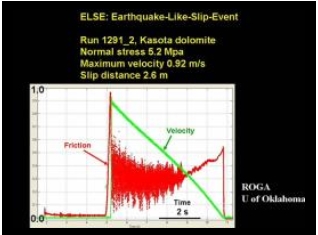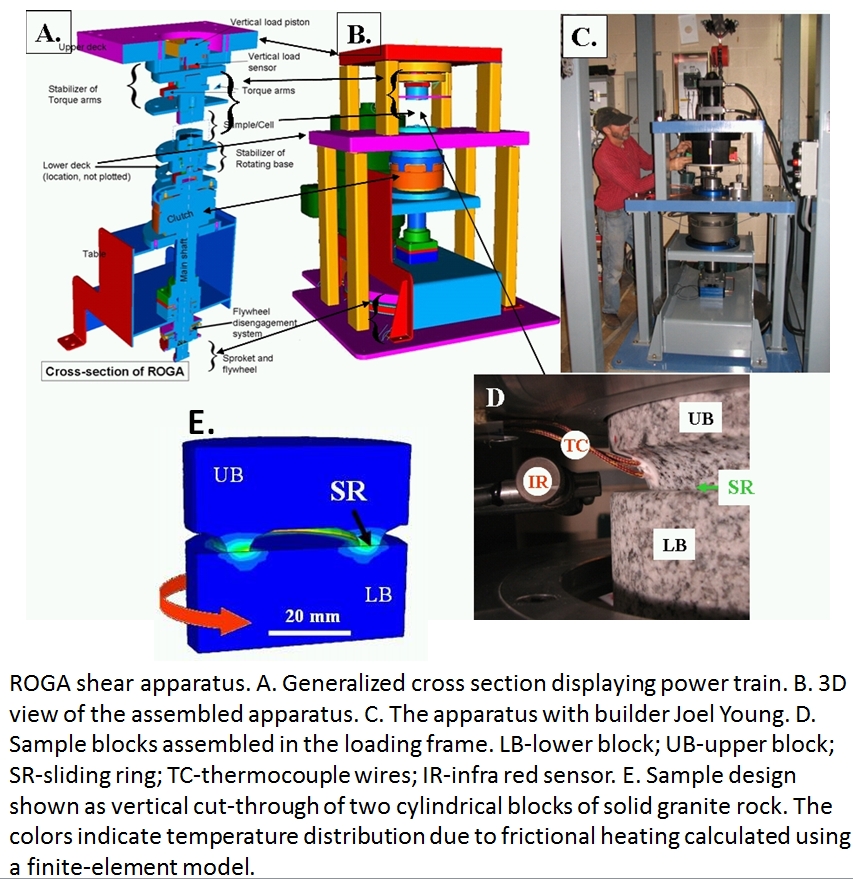Faults undergo profound weakening during the
unstable slip of earthquakes. High-velocity experiments provide an effective tool to test theoretical
models of this weakening, and more importantly to reveal direct, physical evidence for the mechanisms
of dynamic weakening relevant to earthquakes. In an extensive series of experiments at the University
of Oklahoma, we tested more than ten types of rocks and powders at slip velocities up to 1 m/s and at
normal stress up to 15 MPa. The experimental faults were analyzed down to the 10 nm scale, and the
analysis revealed evidence for three weakening mechanisms.
First, powder-lubrication by ultrafine gouge
grains (20-50 nm) that form afresh during slip.
Second, the formation of tiny (~ 1 micron diameter)
powder rolls that spontaneously converted the experimental faults into ‘roller-bearings’. Both these
mechanisms were observed in several lithologies.
Third, fault smoothing (roughness drops
below Ra ~ 0.1 micron), which dominate the weakening of carbonate rocks..
Finally, we tested the experimental
faults by impact loading with a finite amount of energy, which is the expected loading mode on a fault patch
during an earthquake. These experiments showed constitutive friction relations that fundamentally differ from
those of steady-state experiments on the same samples, suggesting that loading style may not be ignored.
We refer to this project as
ROGA: Earthquake Simulation in Laboratory
|
Earthquake-Like-Slip-Event ELSE (click image to watch movie) Following nucleation, a large earthquake propagates as an expanding rupture front along a fault. This front activates countless fault-patches that slip by consuming energy stored in the earth's crust. We simulated the slip of a fault-patch by rapidly loading an experimental fault with energy stored in a spinning flywheel. The spontaneous evolution of strength, acceleration and velocity indicate that our experiments are proxies of fault-patch behavior during Mw = 4-8 earthquakes. We show that seismically determined earthquake parameters (e.g., displacement, velocity, magnitude, or fracture energy) can be used to estimate the intensity of the energy release during an earthquake. Our experiments further indicate that high acceleration imposed by the earthquake rupture-front quickens dynamic weakening by intense wear of the fault zone. Created with Jdi , the visualisation program of ISSI . |

|
|
The experimental system has the essential properties to study earthquake behavior:
(1) Capability to apply normal stress up to 35 MPa, slip velocity of 0.001 to 2 m/s, fast rise to full velocity (<0.1 s), and unlimited slip distance; (2) Continuous slip velocity (no need for periodic slip reversal); (3) A ring design of the fault blocks with small velocity difference between the outer and inner diameters; (4) High frequency, continuous monitoring of the experimental data, including normal load, shear load, slip velocity, displacement normal to the fault surface, and sample temperature. Loading system The apparatus frame is 1.8 m tall with two massive decks. The decks are connected to each other by four rectangle legs. The tested sample is placed between the two decks, and it is loaded by the rotary train from below and by normal stress from above. The power system includes: (1) A 100 HP three-phase electric motor (Reliance) and controller (Baldor) that provides torque of up to 3,000 Nm at any velocity from 0 RPM to 3300 RPM. (2) The main rotary shaft is powered by the motor with 1:6 velocity reduction sprockets. (3) A 225 kg flywheel with its own clutch. (4) An electromagnetic large clutch with full engagement in 30 ms. (5) A hydraulic piston system withh axial load up to 9,500 N. Control system The control system is based on National Instruments components, and it includes a SCXI-1100 with modules 1124 (analog control) 1161 (relay control), 1520 (load cell/strain gage), and 1600 (data acquisition and multiplexer), as well as a USB-6210 (encoder measurements). The system operations are control by a dedicated LabView (NI) program. Monitoring devices are described below. |

|